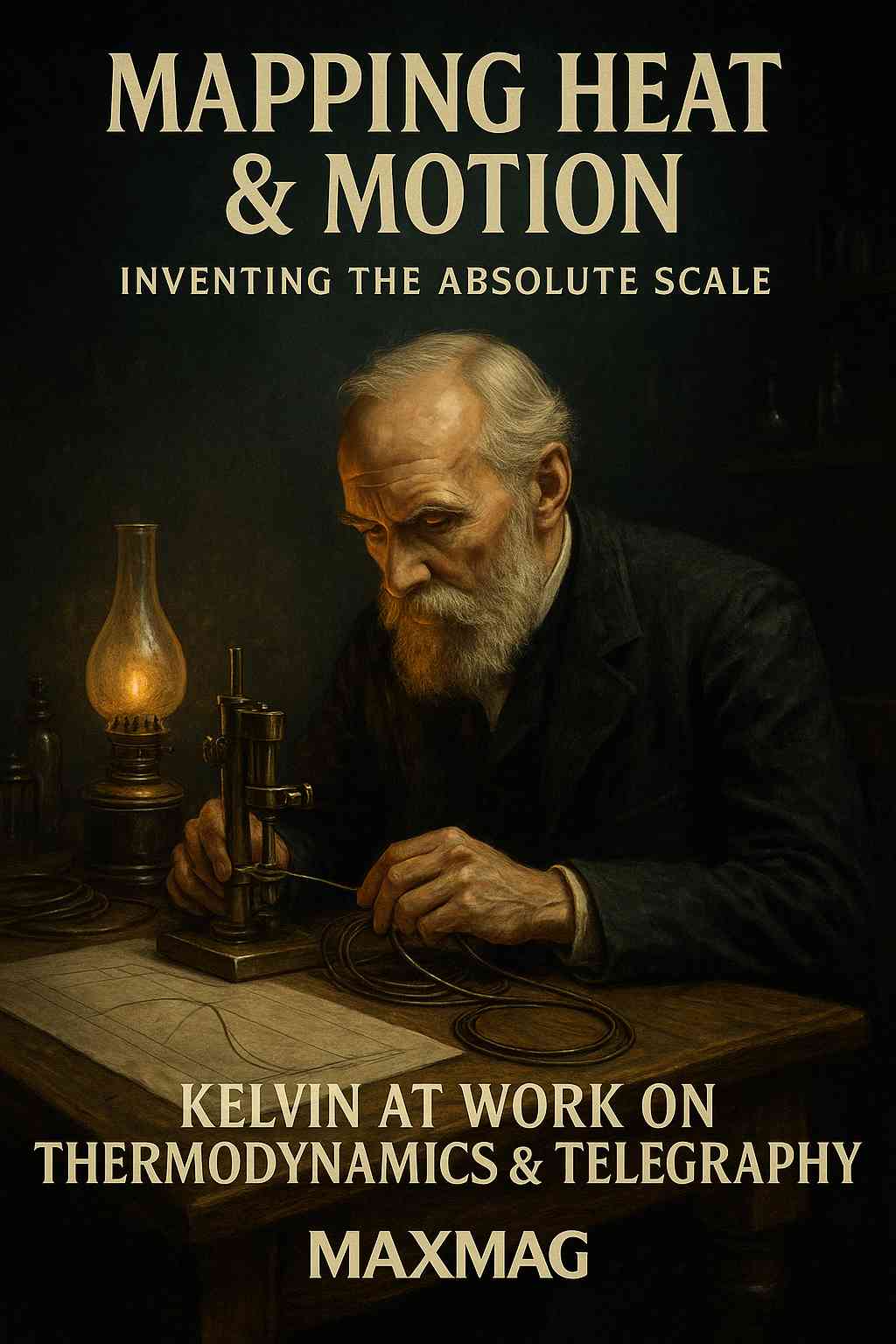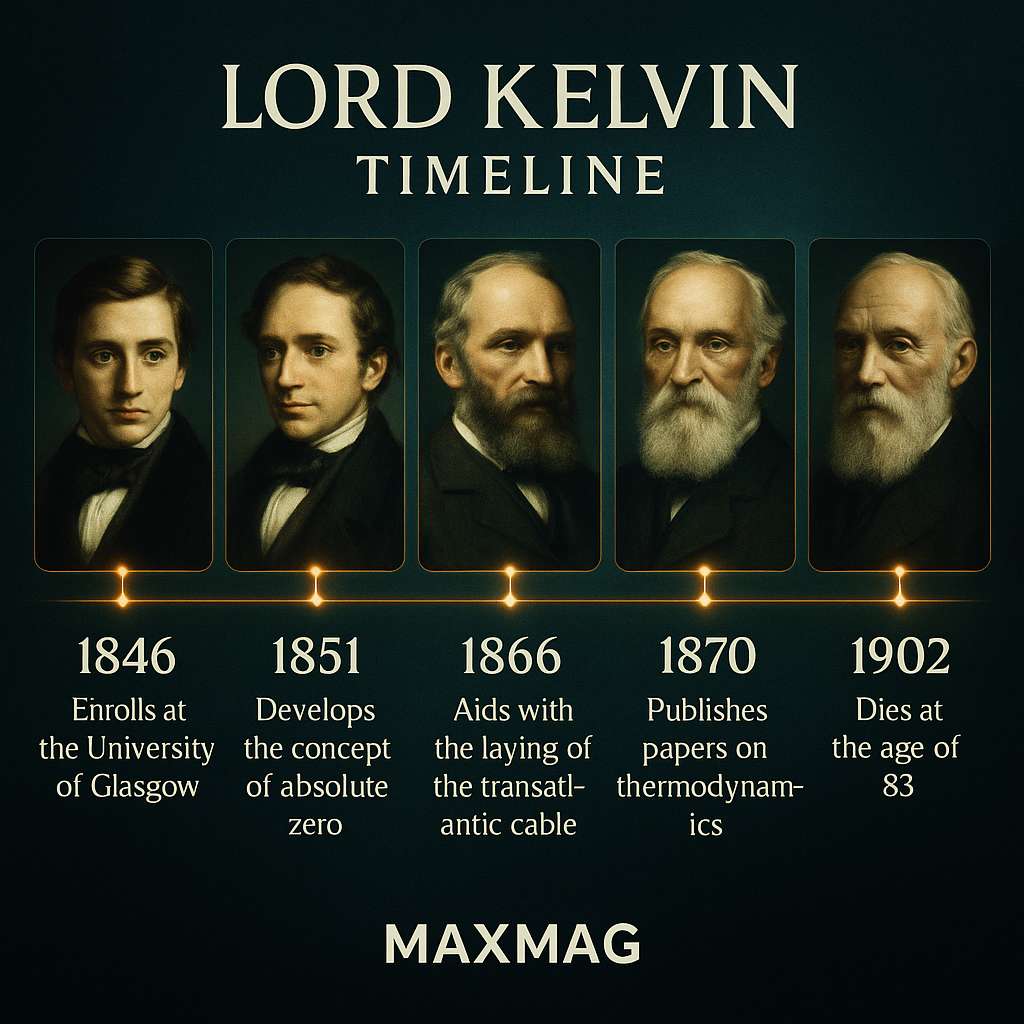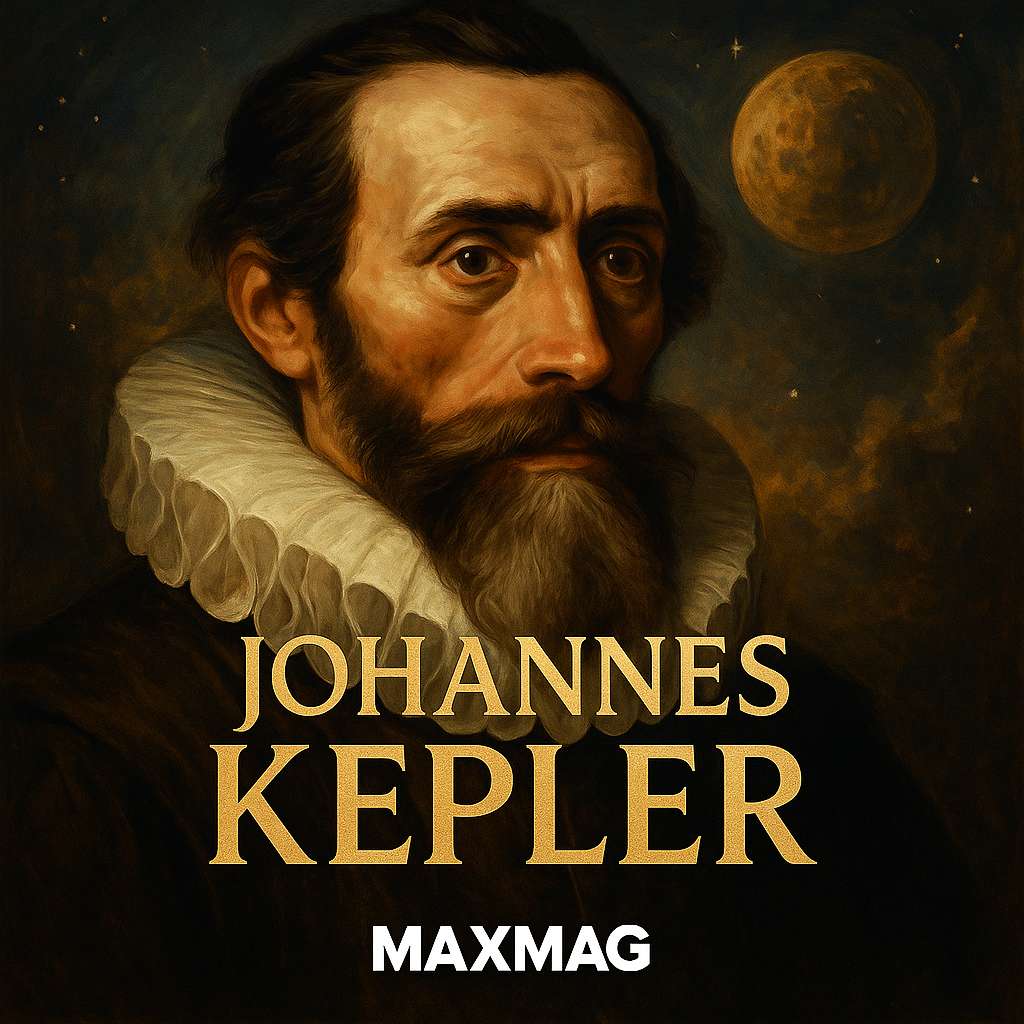
In the Lord Kelvin biography, you meet a man who could turn heat into a ruler, oceans into wires, and Victorian confidence into a scientific brand that still sits in every laboratory today. William Thomson—later Lord Kelvin—was not only a theoretical physicist but also a working engineer, a celebrity, and occasionally a stubborn contrarian. He lived in an era that worshipped steam, empire, and measurement. His gift was to make those instincts precise: to give nature a scale, a standard, a number. Yet the same certainty that helped him build modern thermodynamics also pushed him into famous mistakes, including a public fight over the age of the Earth. Kelvin’s story is a reminder that science is made by humans—brilliant, competitive, practical, and fallible—under pressure from their times.
To understand why his name became a unit, a river title, and a symbol of “hard physics,” you have to follow him from a childhood shaped by mathematics and grief to the deck of cable-laying ships in the Atlantic, and into the lecture halls of Glasgow where he taught for more than half a century. His life is a bridge between thought and machinery, between chalkboard equations and the global infrastructure of communication.
At a glance:
- Who: William Thomson (1824–1907), later Lord Kelvin, Scottish mathematical physicist and engineer.
- Era: High Victorian science and industry.
- Headline contributions: Absolute temperature scale (kelvin), major foundations of the first and second laws of thermodynamics, electrical measurement standards, and key engineering work on the transatlantic telegraph cable.
- Why he matters today: His ideas and instruments helped set the rules and the measuring tools of modern physics and global technology.
Early Life and Education of Lord Kelvin (William Thomson)
William Thomson was born in Belfast in 1824 into a household where numbers were a kind of second language. His father, James Thomson, was a gifted mathematician and teacher who believed—not unusually for the time—that a child’s mind should be trained early and relentlessly. When William was still young, the family moved to Glasgow after his father took a post at the university. That shift mattered: Glasgow was a city at the hinge of the Industrial Revolution, ringing with shipyards, factories, and the politics of progress.
There was also loss. William’s mother died when he was six. The grief was private, but the household reorganised around work and learning. The Thomson children were educated at home with an intensity that could feel both nurturing and pressurised. William entered the University of Glasgow at only ten years old. The campus was not a sheltered monastery; it was a porous place where the noise of industrial life seeped into intellectual ambition. You can almost see the boy walking past workshops and foundries on his way to the lecture room, absorbing an unconscious lesson: knowledge should do things.
By his teens, he was publishing small mathematical notes and impressing senior scholars. At Cambridge, where he studied at Peterhouse, he gained the kind of disciplined mathematical training that Victorian Britain prized. But Cambridge also gave him something else: contact with Europe’s newest physics, especially continental work on heat and energy. He returned north not as a hopeful beginner but as a young intellectual already shaping his field.
Section wrap-up: Kelvin’s early life forged a rare combination—deep mathematics in a city that treated engineering as a civic religion.
Lord Kelvin biography and the Birth of Big Ideas in Thermodynamics
Thermodynamics, when Thomson arrived on the scene, was still an unsettled territory. Steam engines were transforming the world, yet nobody fully understood the rules of heat that powered them. French engineer Sadi Carnot had argued that engines depended on heat flowing from hot to cold. James Prescott Joule, in England, was demonstrating that heat could be converted into work and was itself a form of energy. The ideas didn’t neatly fit. Thomson saw the tension and went after it like a dog with a scent.
How the Lord Kelvin biography leads to absolute zero
Kelvin’s most famous contribution—the absolute temperature scale—came from a simple but radical question: what if temperature could be measured without the quirks of any particular substance? Mercury expands, alcohol expands, gases expand, but each does so in its own way. Thomson wanted a scale rooted in nature’s deep structure. Following the logic of heat engines, he reasoned toward a lowest possible temperature where no more heat could be extracted—absolute zero. The resulting Kelvin scale starts there, making every degree a measure of real physical energy, not just a line on a thermometer.
In plain terms: Celsius tells you how hot something feels relative to freezing and boiling water. Kelvin tells you how much thermal motion exists in matter itself. It’s why physicists speak of 300 K in laboratories and why astronomers describe the universe as a few kelvins above zero. The scale was not theatrical; it was practical precision born from theory. But its impact was cultural too: it gave Victorian science a new authority, a way to say “this is not opinion, this is absolute.”
Energy, entropy, and the “arrow of time”
Kelvin also helped formalise the first and second laws of thermodynamics. The first law—energy conservation—sounds obvious now, but in the 1840s it was a revolution. The second law, which Kelvin refined alongside Rudolf Clausius, carries a darker poetry: energy spreads out, systems run down, and there is no free lunch in the universe. In everyday language, it’s why a hot cup of tea cools down on its own, and why no engine can be 100% efficient. Kelvin even speculated about a future “heat death” of the cosmos, when all energy differences would flatten into silence.
What makes this more than abstract philosophy is how hard Kelvin worked to match theory with the real world of engines, fuels, and materials. His papers stitched together mathematics and experiment into a coherent map of heat. That map became a pillar of modern physics.
Section wrap-up: The thermodynamics in Kelvin’s career was not a side project—it was the framework he offered to an industrial age hungry for rules.
Key Works and Major Contributions of Lord Kelvin
Electricity and the art of measurement
If thermodynamics was Kelvin’s philosophical cathedral, electricity was his bustling marketplace. He was among the first to insist that electrical science would only mature if it could be measured properly. He designed and refined instruments—electrometers, current balances, and galvanometers—that turned invisible forces into readable numbers. That may sound like quiet workshop work, but it changed everything. Once electricity could be standardised, it could be engineered, commercialised, and safely integrated into society.
Kelvin’s name appears on a surprising range of apparatus because he had a knack for recognising the limiting step in a field: not always the theory, but the tool. In the same way that a better microscope expanded biology, Kelvin’s better meters expanded electrical physics.
The transatlantic telegraph: science on the ocean floor
Nothing lifted Kelvin into public fame like the transatlantic telegraph cable. In the 1850s, the dream was audacious: lay a wire across the Atlantic so Britain and America could speak in minutes, not weeks. Michael Faraday had shown that signals would smear and weaken over long submarine cables. Thomson attacked the problem with mathematics, calculating how cable length and insulation would limit speed. He clashed with the company’s chief electrician, Wildman Whitehouse, who dismissed the caution as academic pessimism.
Kelvin didn’t just argue. He went to sea as adviser, and later as a hands-on engineer, riding storms and failures aboard cable ships. When early attempts snapped and died in deep water, he invented sensitive detection devices—the mirror galvanometer and siphon recorder—that could read faint signals without destroying the cable. Those tools, plus his relentless push for better materials, helped make the 1866 cable a success. The public treated the achievement like a moon landing. Kelvin was knighted. He became the visible face of a new kind of scientist: one who could live in the lab and on a ship, and whose equations mattered to global politics and finance.
Maritime inventions and industrial entrepreneurship
The cable work led to wealth, patents, and a lifelong partnership with industry. Kelvin helped redesign the mariner’s compass, making navigation more reliable for iron ships. He advised manufacturers, invested in engineering ventures, and treated innovation as a civic duty. In a century that often separated “pure science” from trade, Kelvin treated the boundary as porous and productive.
Textbooks that shaped a discipline
With Peter Guthrie Tait, he co-wrote Treatise on Natural Philosophy, a massive attempt to build mechanics on energy and mathematical clarity. For generations, it was a standard doorway into advanced physics. Kelvin’s prose could be dense, but his ambition was simple: to make physics a single, connected story.
Section wrap-up: Kelvin’s genius wasn’t one invention; it was a pattern—identify a grand problem, then build the theory and the machinery to solve it.
Methods, Collaborations and Working Style
Kelvin worked like a Victorian storm system: fast, wide-ranging, and occasionally chaotic. He published hundreds of papers, many short and tactical, responding to new experiments or debates almost in real time. Colleagues described him as generous with ideas but also impatient with slow thinking.
His collaboration with Joule is a classic example. Joule supplied painstaking experiments on the mechanical equivalent of heat; Kelvin supplied the mathematical skeleton that allowed others to trust those experiments. Their letters show a mutual respect forged in disagreement: Kelvin sometimes doubted Joule’s conclusions, Joule sometimes pressed Kelvin to accept what the data screamed. The result—the Joule–Thomson effect and broader acceptance of energy conservation—was bigger than either man could have produced alone.
In Glasgow, Kelvin ran his lab like a workshop and a salon. Students remembered his dramatic lectures, full of calculations scribbled at speed, interrupted by sudden, elegant analogies that made abstract forces feel almost touchable. He trained future leaders of physics, including figures who would later define British scientific life.

Controversies, Criticism and Misconceptions in the Lord Kelvin biography
No honest Lord Kelvin biography can avoid the shadow side of confidence. Kelvin believed deeply in the authority of physics. Sometimes that belief was a torch; sometimes it was a blindfold.
The age-of-Earth quarrel in the Lord Kelvin biography
Kelvin’s most famous controversy was his estimate of Earth’s age. Using heat-conduction equations, he argued that the planet had cooled from a molten state and therefore could only be tens of millions of years old—far younger than geologists and Darwinian evolution required. He reduced his estimate over time to roughly 20–40 million years, and he defended it fiercely in public.
The problem was not his mathematics; it was what he didn’t know. Radioactivity, undiscovered in his key years on the topic, adds internal heat and resets the cooling clock. Kelvin’s model assumed a silent Earth losing heat steadily, when in fact it contains hidden furnaces. Later science showed the planet is about 4.5 billion years old. Kelvin’s error became a textbook lesson in how even brilliant reasoning can fail when a key mechanism is missing.
For a modern perspective on how scientists of Kelvin’s time wrestled with geological time, see this Scientific American discussion of the age-of-the-Earth debate.
Public scepticism and technological misfires
Kelvin also doubted early reports of X-rays and had little faith in heavier-than-air flight. These weren’t signs of stupidity; they were signs of a mind trained in one physical regime trying to evaluate a new one. Still, his dismissals became famous because by then his voice carried institutional weight.
Myth-busting: “Kelvin said physics was finished”
A popular myth claims Kelvin declared that physics had nothing major left to discover. In reality, he spoke about “clouds” on the horizon: unresolved problems in radiation and the ether. Ironically, those clouds exploded into quantum theory and relativity. The legend survives because it fits a comforting story about complacence, not because it matches what Kelvin actually said.
Section wrap-up: Kelvin’s controversies don’t shrink his stature; they reveal the real stakes of Victorian science, where argument was as public as invention.
Impact on Physics and on Wider Society
Kelvin helped turn physics into a discipline defined by universal laws and precise measurement. The Kelvin scale sits alongside the metre and the second as part of a shared scientific grammar. Electrical standards he pushed for became the scaffolding of later electrical engineering, from power grids to electronics.
His telegraph work changed the tempo of the world. When the Atlantic cable began operating reliably, diplomacy, commerce, and journalism sped up. A market could react to news in hours rather than weeks. In a quiet way, Kelvin’s mathematics shortened the planet.
There was also a cultural impact. Kelvin was one of the first scientists to become a national celebrity without being a public showman. He embodied the prestige of science during an age that equated progress was both moral and mechanical.

Personal Beliefs, Character and Private Life
Kelvin’s mind lived in equations, but his emotions lived in loyalty. He was devoted to Glasgow, refusing prestigious posts elsewhere and building his identity around the university and the River Kelvin near his lab.
He married twice. His first marriage to Margaret Crum was tender but shadowed by her long illness, which pulled him away from work at times and deepened his private endurance. After her death, he married Frances Blandy, who shared his social world and travel in later life. He had no children, a fact that some contemporaries read as a loss but that perhaps freed him for an unusually large public life.
Faith mattered to him. Kelvin saw Christianity as compatible with natural law, and his religious commitments shaped his resistance to some geological and evolutionary claims. But he was not anti-scientific; he was a man trying to keep coherence between his physics and his metaphysics.
Politically, he leaned toward unionism and the stability of empire. He was a conservative in temperament even when his equations were revolutionary. That mix—radical in method, cautious in worldview—gives the Lord Kelvin biography much of its human tension.
Later Years and Final Chapter of Lord Kelvin (William Thomson)
By the 1890s Kelvin was more than a professor. He was ennobled as Baron Kelvin of Largs, becoming the first working scientist raised to the House of Lords. The title, taken from the river near his laboratory, was a kind of brand before branding existed: it tied a man to a place, and a place to intellectual authority.
He remained extraordinarily active. He advised companies, attended scientific congresses, and maintained a schedule that younger colleagues found exhausting. When he travelled to the United States, he was greeted like a star. Students stamped and cheered at his appearances. That kind of fame for a physicist is hard to imagine now, but it made sense in an age that equated science with civilisation.
Kelvin died in 1907 at his home in Largs, then was buried in Westminster Abbey near Newton and Darwin—an eloquent Victorian triad of mechanics, evolution, and energy.
The Lasting Legacy of the Lord Kelvin biography
The Lord Kelvin biography ends where modern physics begins: with standards, scales, and the disciplined imagination of thermodynamics. Every time you read a temperature in kelvins, you are using a tool Kelvin built to make nature speak in absolute terms. Every time an engineer calculates efficiency limits, they are living inside the world Kelvin helped define.
His legacy is also methodological. Kelvin showed that ideas become powerful when welded to measurement. He treated physical law not as poetry but as infrastructure for civilisation. Yet he also illustrates a subtler lesson: that scientific authority must stay humble before unknown mechanisms. His wrong turn on Earth’s age is not a stain; it is a warning to every confident era that the universe still has surprises.
In that sense, Kelvin belongs to our time as much as his own. We live amid new “clouds” in physics—from dark matter to climate complexity—where measurement, theory, and public consequence collide. Knowing the Lord Kelvin biography helps us see how progress is made: not by flawless geniuses, but by relentless minds willing to connect thought to the material world, and to be corrected by it.
Frequently Asked Questions about Lord Kelvin biography
Q1: Who was Lord Kelvin and why is he important?
Q2: What is Kelvin’s most famous scientific contribution?
Q3: How did Lord Kelvin help build the transatlantic telegraph cable?
Q4: Why was Lord Kelvin wrong about the age of the Earth?
Q5: Was Lord Kelvin only a theorist?
Q6: What is Lord Kelvin’s legacy today?





